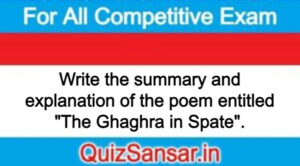
Write the summary and explanation of the poem entitled “The Ghaghra in Spate”.
Write the summary and explanation of the poem entitled “The Ghaghra in Spate”.
Ans.
Summary of the Poem
The poem entitled The Ghaghra in Spate is a colourful pictorial presentation of river Ghaghra. He vividly and picturesquely presents various aspects of landscape such as mountain scape, riverscape, cloudscape etc. It reminds us of A. K. Ramanujan’s poem A River which describes a flood in the river, Vaikai. The river Ghaghra is suddenly overflooded every year and changes its course. The poet minutely observes the changing spectacle of the river. The poem records with compassion and understanding the indescribable sufferings of the victims of flood. He does not express his own emotions of sympathy for the flood-sufferers. He arouses the feeling of compassion and sympathy for the suffering villagers who have lost their all in flood. They have no spirits, which children abundantly show. There is a tinge of satire The sufferings of the victims of flood are the source of recreation or enjoyment. The women in chauffeur-driven cars come from the city to take a look at what the flood had done to the villagers and to witness the stuff which the river water had deposited on the land nearby.
EXPLANATIONS
1. Diving at dusk you wouldn’t know
there’s a flood ‘on’
the landscape is so superbly equipoised
-rice- shoots pricking though
a stretch of water and light
spiked shadows
inverted trees
kingfishers, gulls
as twilight things
the road is a black stretch
running between the stars.
Reference to the Context- These lines presenting vivid and presenting aspects of landscape. have been extracted from the poem entitled The Ghaghra in Spate, written by K. N. Daruwalla Here the poet presents al very colourful picture of the landscape of the river before the approach of the flood. He depicts the calm and serene atmosphere of the Ghaghra river.
Explanation- Going along the river-bank in the growing darkness the evening, no one can think even in his imagination that the violent, fierceful and destructive flood would approach so soon. No commotion can he seen in the atmosphere of the river. It seems perfectly smooth and tranquil. The activities of the river go on as usual. In fact, in this kind of peaceful environment, the seed of a storm lies’ buried and this seed may germinate any time. In other words the peace pervaded in the river landscape is a clear invitation to the flood. Next the poet describes the small and large paddy plants which emerge piercing the bosom of the water. The cars of the corn are seen moving to and from with the gust of wind. Their reflection is visible in the water. The behaviour of the kingfishers and gulls. remain same. They generally come down on the river bank to feed themselves upon the little fishes which are brought towards the bank of the force of the current water. As the darkness deepens, the road which is stretched, seems to be black running between the stars.
Critical Comments: 1. How artistically the poet depicts the calm and balanced environment of the river.
2. The poet depicts the river Ghaghra in words of varied colours such as At twilight ‘the road is a black stretch”.
3. These lines present an outstanding example of Daruwalla’s realistic and original imagery.
2. And suddenly at night
the north comes to the village
riding on river-back
Twenty minutes of a nightmare spin
and fear turns phantasmal
as half a street goes.
churning in the river belly
If only voices could light lamps!
If only limbs could turn to rafted bamboo!
Reference to the Context- As above. Here the poet describes the sadden approach of the flood in the river at night. When the flood arrives, three remains utter darkness all around the river. Even the village situated at the bank of the river is also drowned in darkness. It soon undertakes the village and the villagers.
Explanation- When all the activities in the atmosphere of the river go on as usual and no one can think of an unexpected happening, there is a sudden approach of the flood in the Ghaghra river. The Ghaghra river which flows calmly, suddenly creates commotion. It is a devastating flood. It hardly takes two minutes for the water to rise to a dangerous level. It causes extreme fear and horror among the people living near the bank of the rivers It gives no opportunity to the people (villagers) to understand the situation and to take suitable steps. They seem to be very helpless against the violent form of the river. There are no lamps to light the way for the people who want to flee to safe places. In utter darkness, they feel great difficulty while moving to the places of safety from the flooded river. They move to the places of safety through the means of communication. The transaction of their voices help them greatly in fleeing away. Even there are no boats and makeshift ones to carry them to safety. The Ghaghra river keeps on taking a huge form in order to make great destruction. Before the people can do anything proper, it rises above from the level of danger and is prepared to swallow the village and villagers.
Critical Comments: 1. There is a fair proportion of metaphorical language such as; “fear turns phantasmal”; “half a street churning in the river belly” 2. Here the situation has been recreated like the pictures of a scene of disaster taken by a photographer with a high-powered cinematographic camera. 3. “North” suggests the Ghaghra river.
3. And through the village
the Ghaghra steers her course
thatch and dung cakes turn to river-scum
a buffalo floats over to the rooftop
where the men are stranded
Three days of hunger, and her udders
turn red-rimmed and swollen
with milk-extortion.
Reference to the Context- As above. Here the poet presents a very lively picture of the condition of the village and villagers after the approach of flood in the Ghaghra river. He also describes the pitiable condition of the villagers and cattle.
Explanation- According to the poet, the incident of flood which occurs every year in the Ghaghra river, brings an immense destruction for the villagers. The flood in the river is an unexpected incident. It, without taking any time, begins to flow to the level of danger and soon it crosses the mark of danger and rushes into the village nearby. Its sudden approach does not give the villagers any chance to make their safety. Its rapid, strong and violent flow brings down the mud-and-straw cottages. It forces the cottagers to take shelter on the rooftops which still stand firm and cannot be uprooted easily by the blow of the river. The flood carries with it the dung-cakes which are collected by the villagers in the form heaps. The villagers use the dung cakes as fuel for cooking their meal and other needs. Many domestic cattle become the victims of this violent flood. A buffalo which gets drowned in the water of the flood, dies in the water. The dead body of the buffalo floats on the surface of water and seems to he touching the rooftops of the cottages where the villagers take shelter in order to save their lives. The rooftops of the cottages are made of straw and are erected on the poles of bamboo and they remain unaffected and undamaged for long. The flood takes at least three days to subside. The villagers have to suffer a lot during these three days of the flood. They have to remain hungry. Due to being hungry and spending sleepless nights on the rooftops, their condition becomes very pathetic. They remain under extreme fear until the flood is over. They are waiting and watching anxiously for subsiding the water of the flood. The cattle which are not milked during flood, feel great restless. Due to not milking, their teats are badly swollen and become red.
Critical Comments- 1. The poet’s social concern is permeated with sympathy and compassion. He feels pity and compassion for the victims of misfortune.
2. Udders.. milk-extortion: A rural image, truthfully native in experience.
3. Ghaghra hanging its course every year assumes various shades and colours as various means of day.
4. But it’s when the recedes
that the Ghaghra turns bitchy
sucking with animal-heat
cross-eddies diving like frogmen
and sawing away the waterfront
in a paranoic frenzy
She flees from the scene of her own havoc
arms akimbo, thrashing with pain
Behind her the land sinks
houses sag on to their knees
in a farewell obeisance
And miles to the flank, the paddy fields.
Reference to the Context- As above. Before receding or subsiding, the Ghaghra river makes a great destruction. It gives a great loss to the villagers.
Explanation: According to the poet, the Ghaghra river shows its wicked and malicious nature to the villagers every year. h upsets everything in the village, it breaks the villagers physically, mentally and financially. Every year it leaves them struggling with their fate. The villagers can never get opportunity to survive or flourish in future. When it flows overflooded and reaches above the level of danger, it rushes to the village and whatever falls in its way, it carries with it. The lives of human beings and cattle are lost in it. It knocks down the cottages of the villagers. It forces them to take shelter on the ‘rooftops of the cottages. The villagers cannot carry their cattle to the safe places. In this way, the cattle become the victims of the Ghaghra river. In its rapid circular movements, it makes them drown as being thirsty of the hot blood of the cattle. Then it flees from the scene of its own havoc. While fleeing away, it leaves behind it the signs of its destruction. The real destruction made by the river, become evident only after the flood has subsided. The land, where the water of flood had been staying for a number of days, begins to sink. The houses which had endured the wrath of the flood, can be seen almost on the verge of collapse. The plenty of fish which were brought by the flood water into the rice fields, begin to die with mud and scorching heat of the sun.
Critical Comments: 1. The poet’s presenting his minute observation of the nature of river and destruction made by it.
2. The poet’s depicting two catastrophes, one is the sudden approach of the flood in the river Ghaghra at night, and the second the damage which the river does after the flood has retreated.
3. Vividness and realism of the description made by the poet.
-
Write the critical appreciation of the poem No. 12 entitled Far Below Flowed.
-
Write the critical appreciation of the poem No. 11 entitled Leave this Chanting.






